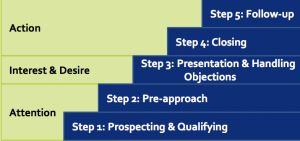During class, we’ve discussed the five-step sales process model, which I found extremely useful and engaging because a couple of my previous employers trained employees to use a step from the same sales process. For example, I used to work in a clothing retail store in Hong Kong, where I was trained for two days on step three, which is presenting and handling objections. As a classmate mentioned, most retail employers tend to focus on step three and neglect the other four steps because in the short-term, step 3 is usually what turns consumers’ interest and desire into action.

During my work as a salesperson in a retail shop, my main tasks included presenting the functions of each product to the customers and try to turn all objections into acceptance. My employer did not mention anything about following up with a customer or having a good closing statement. After acquiring more knowledge about the other four steps in the process, I believe that all employers should take all five steps in the process seriously. Even if a sales person successfully delivers the products’ benefits and gains a sales transaction, it will eventually hurt the company if the consumer experiences buyer’s remorse. Therefore, I think it is extremely important to follow up with customers for two main reasons. First of all, it will reduce any dissatisfaction that the customers may experience. Secondly, the company can gain additional information about their target market. For example, in the retail industry, it may be inconvenient to phone every customer about his or her purchase experience. However, the company can ask for consumers’ e-mail addresses upon purchase and send them a feedback form or provide an online chat forum for consumers on the company website.